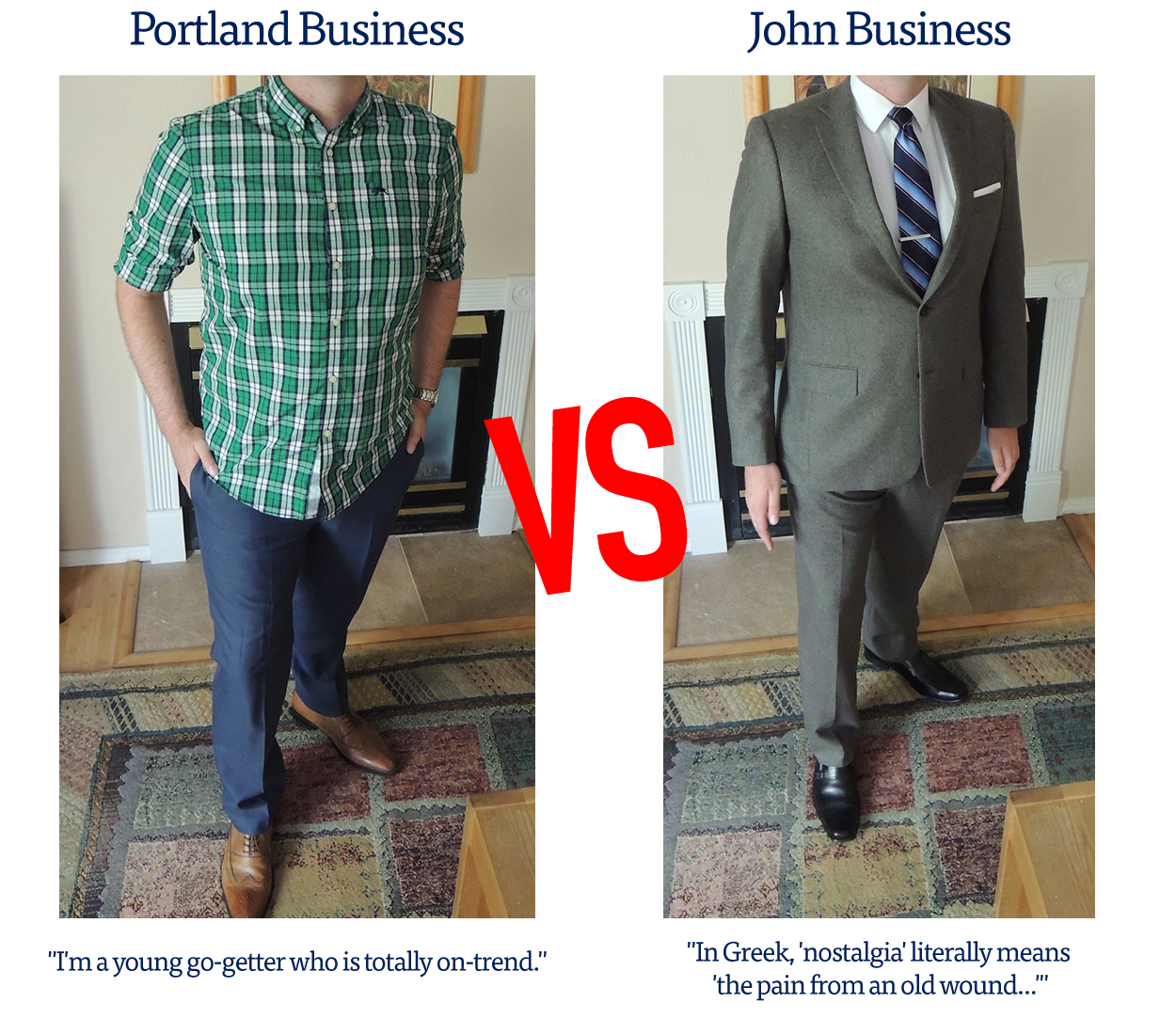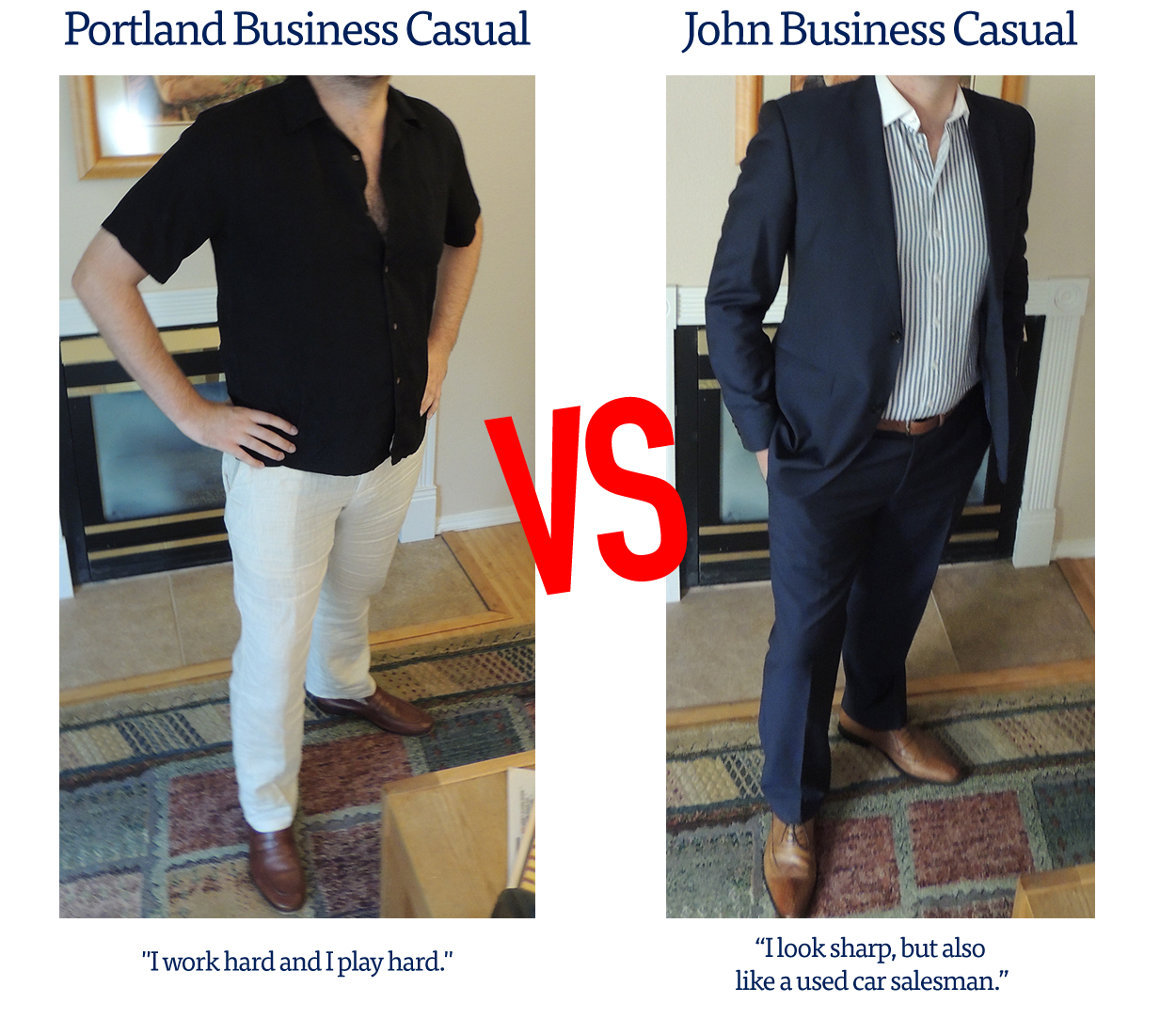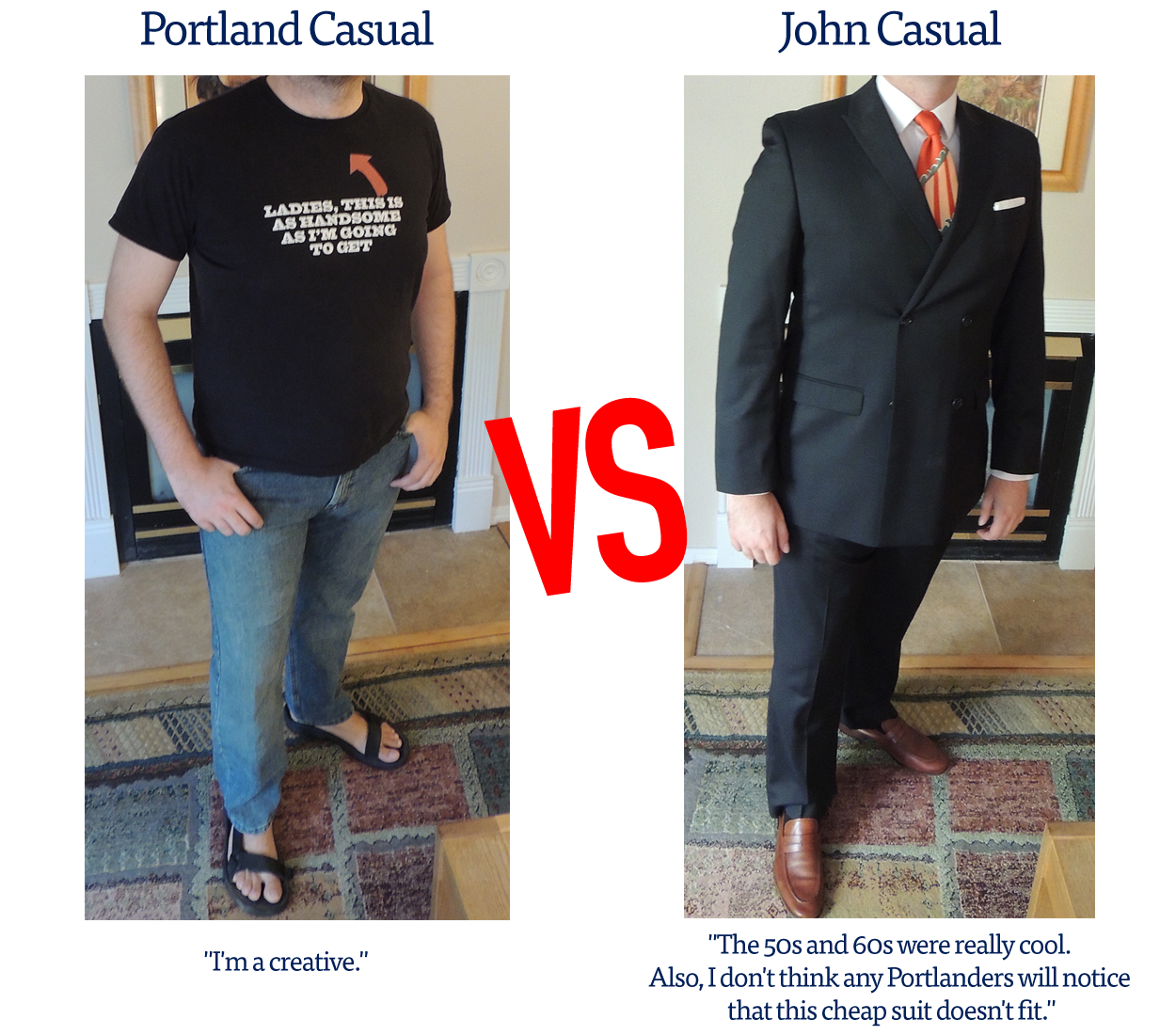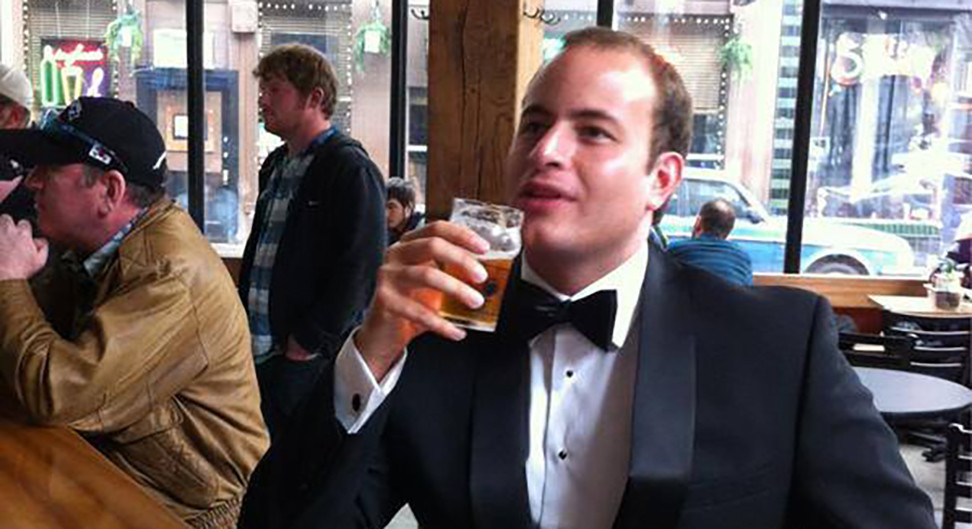Local Fast Food Critic Tackles Portland’s Professional Dress Code
Sometime in the 90s, “Casual Friday” gradually overtook the rest of the work week. Now, nearly every office outside the banking and legal rackets is a casual one.
This is especially true of the creative industry, and doubly so in Portland. Let New York have its suits and ties. Let Los Angeles have its summery business casual. Let Chicago have whatever it is that Chicago has (pizza casserole, I guess). Portland is that town where you can actually do you.
The suit & tie is more of a downtown hotel bar thing.
Just keep in mind that Portland does, in fact, have an unofficial professional dress code. It’s on the casual end of business casual. It requires you to look presentable in interviews (read: like you didn’t just toss on some clothes after rolling out of bed 10 minutes prior) and to wait until you get the job to break out the funny t-shirts, beat-up jeans and Chucks. Visible tattoos, piercings and gauges are welcome. The suit & tie is more of a downtown hotel bar thing.
Many of you, I’m sure, figured this out on your own. The less aware of us didn’t pick up on the unofficial dress code until we got an email from our staffing agency just after we bought a new tie to match our blue mohair suit for that upcoming job interview.

“No suits or ties,” it read, “[company name redacted] thinks of itself as a casual, laid-back workplace. Suits are more of [insert competitor here]’s thing. How about that nice yellow button-up you wore last time we met? Maybe with some nice, not-too-worn jeans.”
One of my friends found out when a manager somewhat-jokingly threatened to cut off his tie if he ever walked into the office wearing one again.
A hobo pirate on the Willamette is not particularly interested in speaking to a dude in an immaculately pressed suit.
There is a good reason for casual attire—nothing looks less creative than an office of men and women all wearing suits ranging from charcoal to navy—but it sometimes feels like you’re being asked to wear 17 pieces of flair to express yourself. Modern workplaces being filled with dudes in plaid shirts with rolled up sleeves doesn’t exactly dispel the feeling.
As Portland’s well-dressed, most eligible up-and-coming creative word guy, the city’s unofficial dress code has proven a sticky wicket. You want to wear what you feel comfortable in, but also in a way that others feel comfortable around you.
Working as a journalist, I quickly learned the importance of dressing appropriately for interviews. A hobo pirate on the Willamette is not particularly interested in speaking to a dude in an immaculately pressed suit. Nor will a lawyer take you seriously if you show up in a ragged pair of jeans and a t-shirt depicting Che wearing a Che shirt.

Another issue with the businesswear of the past is one of pop culture. A person in a suit and tie trying to get in the ad game looks like someone who watched a few episodes of Mad Men and decided this was the career for him or her. It’s akin to the frat bro you meet during dollar beers at Taylor’s telling you you’re going to work for him one day because he’s majoring in business—except the latter probably has slightly more expertise, no matter how many times the former has watched Don Draper pitch “the Carousel.”
As a test, go out to a bar in a t-shirt and beat-up jeans. Then try a button up and some nicer jeans. Now, go to that bar in a suit and tie. You’ll notice a distinct difference both in who approaches you and how these people chat with you.
I’ve ended up with a series of outfits for every social occasion. There’s my outfit for networking (button up and slacks), my outfit for eating at and reviewing Taco Bell (suit and tie), my outfit for interviewing at an agency (button up and slacks), my outfit for interviewing at an old media company (single-breasted suit and conservative tie), my outfit for moodily drinking at the end of the bar (double-breasted suit and tie), to name a few. The more casual the ensemble, the more stubble I grow out to better fit in.
Visible drawstrings are about as dignified as long johns with a buttflap and have a mere fraction of the functionality.
I have a pair of jeans—two, even!—but they remain on hangers in the back of the closet. Denim has the misfortune of being both uncomfortable and unpresentable. Chinos are the way to go if you wish to swathe your legs in cotton, but wool, linen and even many polyester blends are better options in most circumstances.
The last time I wore jeans was when I was working on a strip club guide, incognito, a year and a half ago. Also, avoid pants with drawstrings unless you want everyone to laugh at you, and they will. Or at least, I will. Visible drawstrings are about as dignified as long johns with a buttflap and have a mere fraction of the functionality.
Wearing traditional business attire has its charm. People mistake you for being a lawyer or a doctor—someone who doesn’t spend most days scouring online sales, and has a decent tailor.
Many articles I’ve been pitched and written sprouted from the idea “hey, wouldn’t it be funny if we photographed/filmed John doing this undignified thing?” It took years of hard work to get to the point where my bosses now tell me I look weird in “normal” clothes.

The proudest moment of my time as an interim editor was when a bright, young intern walked up to me and said, “Look, John, I wore a tie!” I’m getting watery-eyed just thinking about it. Sure, there are the occasional Portland culture warriors challenging your Portlandness, but it’s a small price to pay for looking sharp.
These are mostly optional social situations, however. The unofficial dress code is less optional for job-seekers like you and me. Here are some handy sartorial tips I’ve learned over the years:
1) In the event that a recruiter wants to speak with you again after the initial phone interview, ask what kind of attire is appropriate. This shows that you understand the importance of fitting in.
2) When attending a networking event, do not dress like the most successful person in the room. I cannot stress this enough, people: other job-seekers will erroneously assume that you have work for them or job connections or something, and the important people to network with will assume you aren’t a penniless freelancer.
3) Look at what people are wearing in catalogs aimed at young professionals and do that.
4) Dress and act like your more successful, gainfully-employed friends.
5) Say “screw it” and go the eccentric route. Show up to that job interview in an ascot and smoking jacket.
6) On second thought, don’t do that. Wearing a smoking jacket outside of your house only makes you look like a fool. Many companies still hire fools, mind you, but you’re going to have to disguise yourself better.
7) Any company that forces you to wear jeans isn’t a company worth working for.
8) Remember: you are not dressing as you. You are dressing as a prospective ambassador for this company. If your personal style falls outside the confines of the unofficial dress code, wait until you are a valuable enough asset to the company to be yourself.
John Locanthi is a contributing writer at the Willamette Week, where he tastes the hastily made, modestly priced food of the common man in a weekly column called Haute-N-Ready.
This work is licensed under a Creative Commons Attribution-ShareAlike 4.0 International License.


